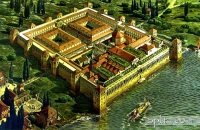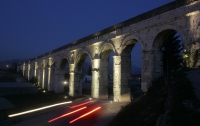The Roman aqueduct of Spalato (present Spilt, Croatia) was built simultaneously with the Palace of Diocletian (ca 243 - 316 CE) in the late third and/or early fourth century.
It was used for the water supply of the imperial residences and weaving workshops within the palace, and probably for the villages in the area.
| Time table Salona and Spalato (Split) |
| 3 -1 c BCE |
Delmat settlements in Salona's core; Greek colonization |
| 2 - 1 c |
Conflicts between Rome and Delmats |
| 117-9 |
Roman general Metellus Macedonicus invaded Salona |
| 48/47 |
Julius Caesar makes Urbs vetus of Salona into Colonia Martia Iulia Salona
|
| 27 |
Octavian defeats Delmats |
|
Salona becomes capital of the Roman province of Dalmatia |
| Augustan |
Construction of the Aqueduct of Salona |
| 1st c CE |
Construction of the Forum, theater etc in Salona |
| 100 |
Urbs Novus |
| Late 2nd c |
Refortification of Salona |
| Late 3rd c |
Flourishing Salona; residence of Diocletian in Spalato |
| Early 4th c |
Construction of the Aqueduct of Spalato (Split), Christianity |
| 6th c |
Croats; christianity flourishes; Episcopal center |
| 614 |
Salona abandoned because of Slav invasions |


